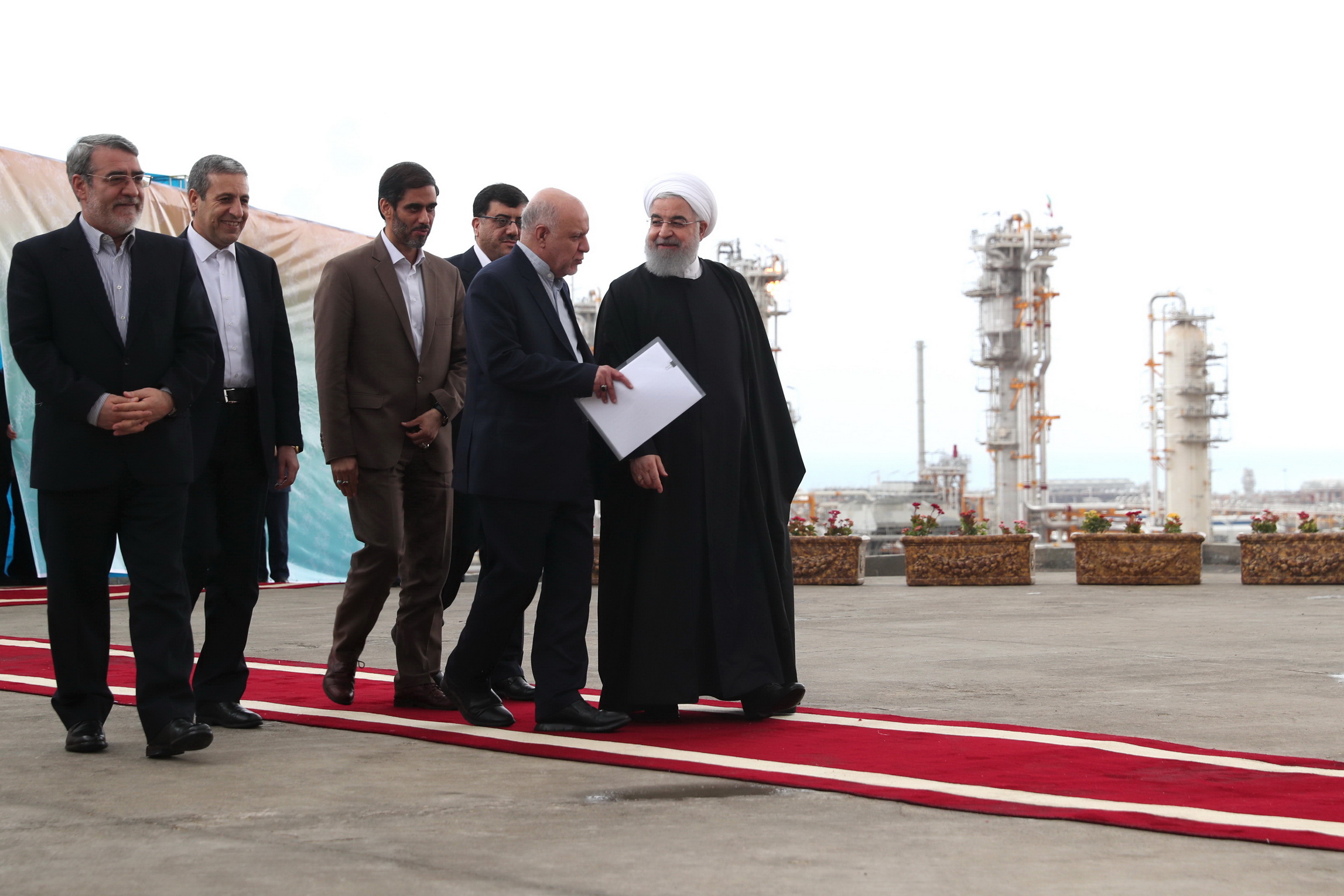Iran’s President Hassan Rouhani has inaugurated two gas projects on the sidelines of a ceremony held to mark the launch of four new phases to develop the South Pars natural gas field located in the Persian Gulf.
Using videoconferencing technology, Rouhani opened the transfer line that delivers ethane from Site 2 to Site 1 of South Pars Gas Field, located in Asaluyeh in the southern province of Bushehr, on March 17. He also presided over the inauguration of a plant that produces the natural gas odorant mercaptan.
Phases 13, 22, 23, 24 of the South Pars Gas Field officially started operation in Kangan County on March 17 at a ceremony that was held during Rouhani’s visit to Bushehr Province.
Speaking at the opening ceremony of four new phases, Rouhani said, “We reached 25 active phases from 10 in South Pars, and with these four phases, 100 cubic metres were added to the country’s gas production”, the official website of the Iranian president reported.
The Iranian president said that the “opening South Pars phases indicates that the Iranian nation has continued, and will continue, their path to development.”
“The United States thought that sanctions will stop our progress and development, but the history-making, devoted people of Iran disappointed them,” Rouhani added.
The development plan for phase 13 and phases 22 to 24 of South Pars are expected to yield a daily production capacity of 113 million cubic meters of gas, 100 million cubic meters of methane, 150,000 barrels of gas condensate, 800 tons of granular sulfur, 2.1 million tons of liquid gas per year, and two million tons of ethane.
According to the Iranian government’s projections, each plant has a capacity to process 56 million cubic meters of gas per day and convert it to LPG, ethane, condensate and sulfur worth $5.5 billion a year at current market rates. Tehran is hoping that revenue will account for 2 percent of Iran’s GDP, which was $430 billion in 2017.
Iran's total gas production capacity from the South Pars gas field is currently 600 million cubic meters a day that, with the commissioning of these four new phases, is expected to rise to over 700 million cubic meters per day.
After the inauguration of two refineries being built with $10 billion of investment capital, Iran’s daily gas production is expected to surpass that of Qatar, with which Iran shares the huge South Pars offshore field beneath the Persian Gulf.
Iran had awarded development of phase 11 to a consortium led by Total, but the French company left the project after the United States threatened to impose sanctions on companies doing business in Iran. When Total left, China National Petroleum Corp (CNPC) was to take over according to the contract, but the Chinese company also suspended investment in response to pressure from Washington.
Nevertheless, the state-run Chinese energy giant Sinopec has offered Iran a $3 billion deal on further development of an Iranian oilfield that the two countries are already working on.
Iran is in talks with several domestic companies to extract more oil from South Pars after foreign companies abandoned the plan in the face of American sanctions. Some 400 Iranian companies have been taking part in the development of the South Pars gas field through supplying equipment to related projects.
The Director of Integrated Planning Department of National Iranian Oil Company Karim Zobeidi said on March 11 that there were 125 oilfields and 59 gas fields in the country, adding there are now more than 200 undeveloped reservoirs in Iran. According to some projections, only about 42 percent of Iran’s oil reserves and 10 percent of its gas has been extracted.







 President Aliyev emphasized the critical role of the North-South Transport Corridor in fostering transport cooperation between Azerbaijan and Russi...
President Aliyev emphasized the critical role of the North-South Transport Corridor in fostering transport cooperation between Azerbaijan and Russi...
 Armenian sappers commenced on Monday mine-clearance operations in the territories adjacent to the Saint Mary Church in village of Voskepar (Armenia...
Armenian sappers commenced on Monday mine-clearance operations in the territories adjacent to the Saint Mary Church in village of Voskepar (Armenia...
 The Mine Action Agency of Azerbaijan (ANAMA) reported on Thursday the discovery of a significant amount of explosives in the Khojavand district of ...
The Mine Action Agency of Azerbaijan (ANAMA) reported on Thursday the discovery of a significant amount of explosives in the Khojavand district of ...
 Russian Foreign Minister Sergei Lavrov has reasserted that Moscow has no intentions to stop the fighting in Ukraine, even if peace talks commence.
Russian Foreign Minister Sergei Lavrov has reasserted that Moscow has no intentions to stop the fighting in Ukraine, even if peace talks commence.
 Iran’s Foreign Minister, Hossein Amir-Abdollahian, has labeled a foiled Israeli drone attack in certain parts of the country as a "failure" for Isr...
Iran’s Foreign Minister, Hossein Amir-Abdollahian, has labeled a foiled Israeli drone attack in certain parts of the country as a "failure" for Isr...
 Iran has refuted reports of alleged damage to Shimon Peres Negev Nuclear Research Centre located southeast of Dimona, Israel, during the recent air...
Iran has refuted reports of alleged damage to Shimon Peres Negev Nuclear Research Centre located southeast of Dimona, Israel, during the recent air...



